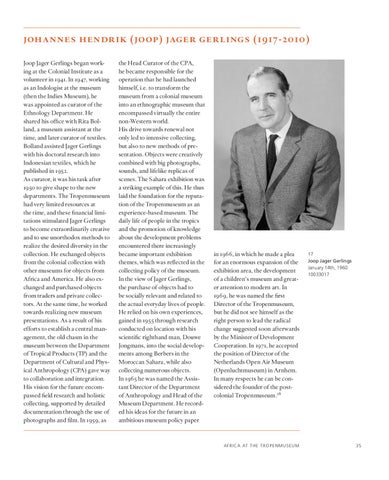johannes hendrik (joop) jager gerlings (1917-2010) Joop Jager Gerlings began working at the Colonial Institute as a volunteer in 1941. In 1947, working as an Indologist at the museum (then the Indies Museum), he was appointed as curator of the Ethnology Department. He shared his office with Rita Bolland, a museum assistant at the time, and later curator of textiles. Bolland assisted Jager Gerlings with his doctoral research into Indonesian textiles, which he published in 1952. As curator, it was his task after 1950 to give shape to the new departments. The Tropenmuseum had very limited resources at the time, and these financial limitations stimulated Jager Gerlings to become extraordinarily creative and to use unorthodox methods to realize the desired diversity in the collection. He exchanged objects from the colonial collection with other museums for objects from Africa and America. He also exchanged and purchased objects from traders and private collectors. At the same time, he worked towards realizing new museum presentations. As a result of his efforts to establish a central management, the old chasm in the museum between the Department of Tropical Products (TP) and the Department of Cultural and Physical Anthropology (CPA) gave way to collaboration and integration. His vision for the future encompassed field research and holistic collecting, supported by detailed documentation through the use of photographs and film. In 1959, as
the Head Curator of the CPA, he became responsible for the operation that he had launched himself, i.e. to transform the museum from a colonial museum into an ethnographic museum that encompassed virtually the entire non-Western world. His drive towards renewal not only led to intensive collecting, but also to new methods of presentation. Objects were creatively combined with big photographs, sounds, and lifelike replicas of scenes. The Sahara exhibition was a striking example of this. He thus laid the foundation for the reputation of the Tropenmuseum as an experience-based museum. The daily life of people in the tropics and the promotion of knowledge about the development problems encountered there increasingly became important exhibition themes, which was reflected in the collecting policy of the museum. In the view of Jager Gerlings, the purchase of objects had to be socially relevant and related to the actual everyday lives of people. He relied on his own experiences, gained in 1955 through research conducted on location with his scientific righthand man, Douwe Jongmans, into the social developments among Berbers in the Moroccan Sahara, while also collecting numerous objects. In 1965 he was named the Assistant Director of the Department of Anthropology and Head of the Museum Department. He recorded his ideas for the future in an ambitious museum policy paper
in 1966, in which he made a plea for an enormous expansion of the exhibition area, the development of a children’s museum and greater attention to modern art. In 1969, he was named the first Director of the Tropenmuseum, but he did not see himself as the right person to lead the radical change suggested soon afterwards by the Minister of Development Cooperation. In 1971, he accepted the position of Director of the Netherlands Open Air Museum (Openluchtmuseum) in Arnhem. In many respects he can be considered the founder of the postcolonial Tropenmuseum.28
A FRI C A AT TH E TRO PENMU SEU M
KIT-Africa_HT.indd 35
17 Joop Jager Gerlings January 14th, 1960 10033017
35
12-08-11 10:56
